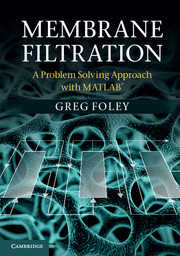Book contents
- Frontmatter
- Dedication
- Contents
- Preface
- Abbreviations
- 1 Introduction to membrane filtration of liquids
- 2 Dead-end filtration
- 3 Crossflow microfiltration
- 4 Ultrafiltration flux theories
- 5 Ultrafiltration process analysis and design at the limiting flux
- 6 Diafiltration at the limiting flux
- 7 Ultrafiltration and diafiltration with incomplete rejection
- 8 The osmotic pressure model applied to ultrafiltration and diafiltration
- 9 Reverse osmosis and nanofiltration
- 10 Membrane fouling
- Appendix Mathematical and computational background
- Index
- References
3 - Crossflow microfiltration
Published online by Cambridge University Press: 05 July 2013
- Frontmatter
- Dedication
- Contents
- Preface
- Abbreviations
- 1 Introduction to membrane filtration of liquids
- 2 Dead-end filtration
- 3 Crossflow microfiltration
- 4 Ultrafiltration flux theories
- 5 Ultrafiltration process analysis and design at the limiting flux
- 6 Diafiltration at the limiting flux
- 7 Ultrafiltration and diafiltration with incomplete rejection
- 8 The osmotic pressure model applied to ultrafiltration and diafiltration
- 9 Reverse osmosis and nanofiltration
- 10 Membrane fouling
- Appendix Mathematical and computational background
- Index
- References
Summary
Introduction
In Chapter 2 it was seen that dead-end filtration is characterised by the flow of suspension normal to the filter. In crossflow microfiltration (CFMF), the suspension flows parallel (or tangential) to the membrane. The rationale behind the crossflow mode of operation is that the ‘scouring’ action of the flow parallel to the membrane inhibits the growth of filter cake, thus creating the potential for high filtrate fluxes and steady state operation. CFMF is normally considered when the solids in a suspension prove difficult to separate in a dead-end filter or a centrifuge. Dead-end filtration is difficult when the particles are ‘small’ and have the tendency to form highly resistant and compressible filter cakes. Problems in centrifuging suspensions arise when the particles are small and have densities that are close to that of the suspending fluid. All of the above characteristics are typical of microbial suspensions. Consequently, crossflow systems have the potential to be economically viable for bacterial cells (as compared to centrifugation) and larger filamentous cells (as compared to pre-coat rotary vacuum filtration). CFMF is also useful for separating shear sensitive animal cells, for clarifying beverages such as beer and fruit juice, in separation of blood cells from plasma (plasmapheresis) and in sterile filtration of pharmaceuticals. Use of crossflow microfiltration as a key component of submerged membrane bioreactors (MBRs) is now commonplace. These devices combine biological waste treatment with membrane filtration, the performance of the latter being improved by the presence of the air bubbles required by the biological reactions. This use of air sparging to improve membrane filtration is discussed later in this chapter.
It is very important to remember that comparing dead-end and crossflow microfiltration is not really comparing like with like. In dead-end processes, a filter cake is recovered. An example of this is use of rotary vacuum filters in production of cakes of baker's yeast used in the bread making industry. In CFMF, however, no substantial cake is formed and the best that can be achieved is to concentrate a suspension. Both dead-end and crossflow techniques can, of course, be used for soluble product recovery.
- Type
- Chapter
- Information
- Membrane FiltrationA Problem Solving Approach with MATLAB, pp. 48 - 87Publisher: Cambridge University PressPrint publication year: 2013



